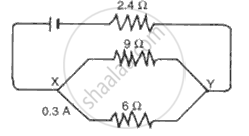Advertisements
Advertisements
प्रश्न
Three 2 V cells are connected in series and used as a battery in a circuit.
What is the p.d. at the terminals of the battery?
उत्तर
The potential difference across each cell is 2 V. So, the potential difference at the terminals of the battery is 3 x 2 V = 6 V.
APPEARS IN
संबंधित प्रश्न
How many milliamperes as there in 1 ampere?
A p.d. of 6 V is applied to two resistors of 3 Ω and 6 Ω connected in parallel. Calculate:
(a) the combined resistance
(b) the current flowing in the main circuit
(c) the current flowing in the 3 Ω resistor.
Draw a circuit diagram showing two lamps, one cell and a switch connected in series.
How can you change the brightness of the lamp?
State two differences between the e.m.f and terminal voltage of a cell.
A 720 W heater operates from a 220 V line voltage. Calculate:
(a) The electrical energy consumed by the heater in 3 h.
(b) The cost of electrical energy consumption at the rate of 60 paise per kWh.
In the circuit shown in fig. 6, find the reading of the ammeter A when the switch S is
(a) Opened.
(b) Closed.

A current of 0.3 A is flowing through a branch of 6 Ω resistors in a junction as shown in fig. . Calculate the
(a) P.d. across the junction XY,
(b) Current flowing through 9Ω and 24Ω
( c) P.d. across 24 Ω resistor, and
( d) e.m.f. of the cell.

Water : pipe :: Electric current : ______.
An ammeter is always placed in parallel with the circuit.
